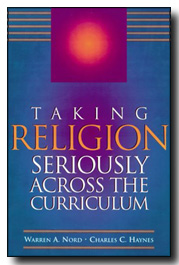Religion in the Classroom
- GREGORY J. RUMMO
Religion's influence in the world is pervasive. Even atheists will concede this fact. Therefore, a well-rounded education must include religion from the start. "An elementary school curriculum that ignores religion gives students the false message that religion doesn't matter to people that we live in a religion-free world," write Warren A. Nord and Charles C. Haynes in their 1998 book, Taking Religion Seriously Across the Curriculum.
 |
"This
is neither fair nor accurate," the authors continue. "Silence about religion also
denies students the promise of a good education. If they are to understand the
world they live in, they must be exposed at an early age to the religious dimensions
of society, history, literature, art, and music. Without this foundation, they
will be unprepared for the more complex and critical study of the upper grades."
During his first term, President Clinton made clear that he supported the
teaching of religion in public schools. "Schools do more than train children's
minds. They also help to nurture their souls by reinforcing the values they learn
at home and in their communities. I believe that one of the best ways we can help
our schools to do this is by supporting students' rights to voluntarily practice
their religious beliefs, including prayer in schools," the president said. "For
more than 200 years, the First Amendment has protected our religious freedom and
allowed many faiths to flourish in our homes, in our work place and in our schools."
Clinton directed his education secretary, Richard W. Reilly, to provide every
public school district in America with a statement of principles addressing the
extent to which religious expression and activity are permitted.
These
guidelines titled "Religious Expression in Public Schools" were
sent out in August 1995. (They were revised in May 1998 to reflect the Supreme
Court declaring the Religious Freedom Restoration Act unconstitutional.)
The revised guidelines, posted on the Department of Education's website, address
topics such as student prayer and religious discussion, graduation prayer and
baccalaureates, student assignments, religious literature, and the teaching of
values.
"Public schools ... may teach about religion, including the Bible
or other scripture: the history of religion, comparative religion, the Bible (or
other scripture) as literature, and the role of religion in the history of the
United States and other countries."
This may shock those who assume the
Bible is forbidden inside the public school classroom, a misconception likely
due to widespread misunderstanding about the separation of church and state. Public
schools once not only tolerated but encouraged prayer. Students were allowed to
read their Bibles. Generations of children read from the New England Primer,
a textbook of prayers and questions and answers taken directly from the Scriptures.
Public schools also used McGuffey's Readers, compiled by Dr. William
H. McGuffey. Essays such as "What I Live For" which addressed God, heaven,
and the spiritual dimension of people were not a cause for constitutional
concern. From their publication in 1836 until 1920, they sold more than 122 million
copies.
 This is Meaghen Gonzalez, Editor of CERC. I hope you appreciated this piece. We curate these articles especially for believers like you.
This is Meaghen Gonzalez, Editor of CERC. I hope you appreciated this piece. We curate these articles especially for believers like you.
Please show your appreciation by making a $3 donation. CERC is entirely reader supported.

Acknowledgement
Gregory J. Rummo. "Religion in the Classroom." The Record (July 18, 2002).
This article reprinted with permission of The Record of Hackensack, NJ.
The Author
Syndicated columnist and business executive Gregory J. Rummo's new book, The View from the Grass Roots, is an anthology of his commentaries written about life in 20th- and 21st-century America. The Live Wire is Mr. Rummo's syndicated column, which appears Tuesdays and Sundays in The New Jersey Herald.
Copyright © 2002 The Record

